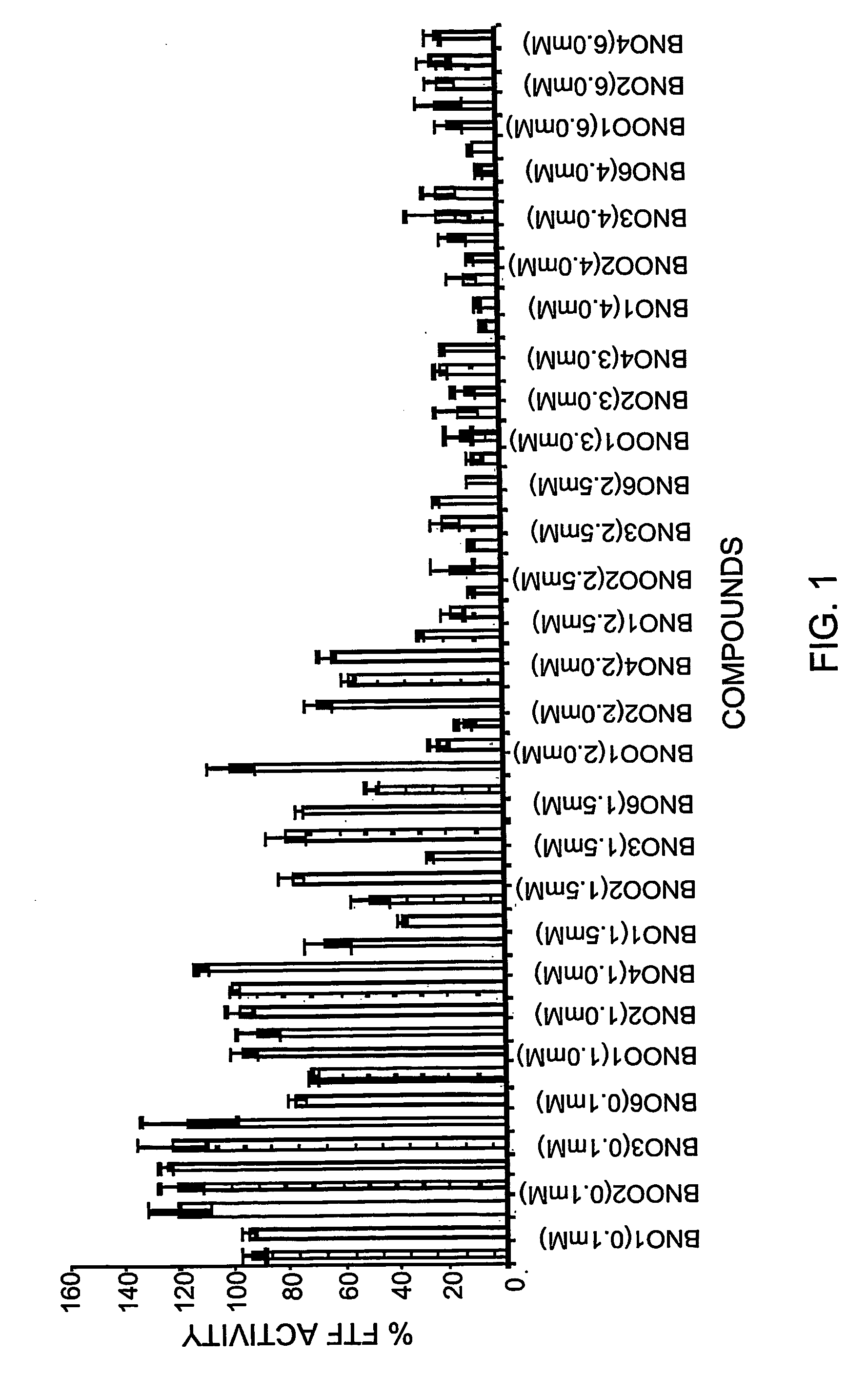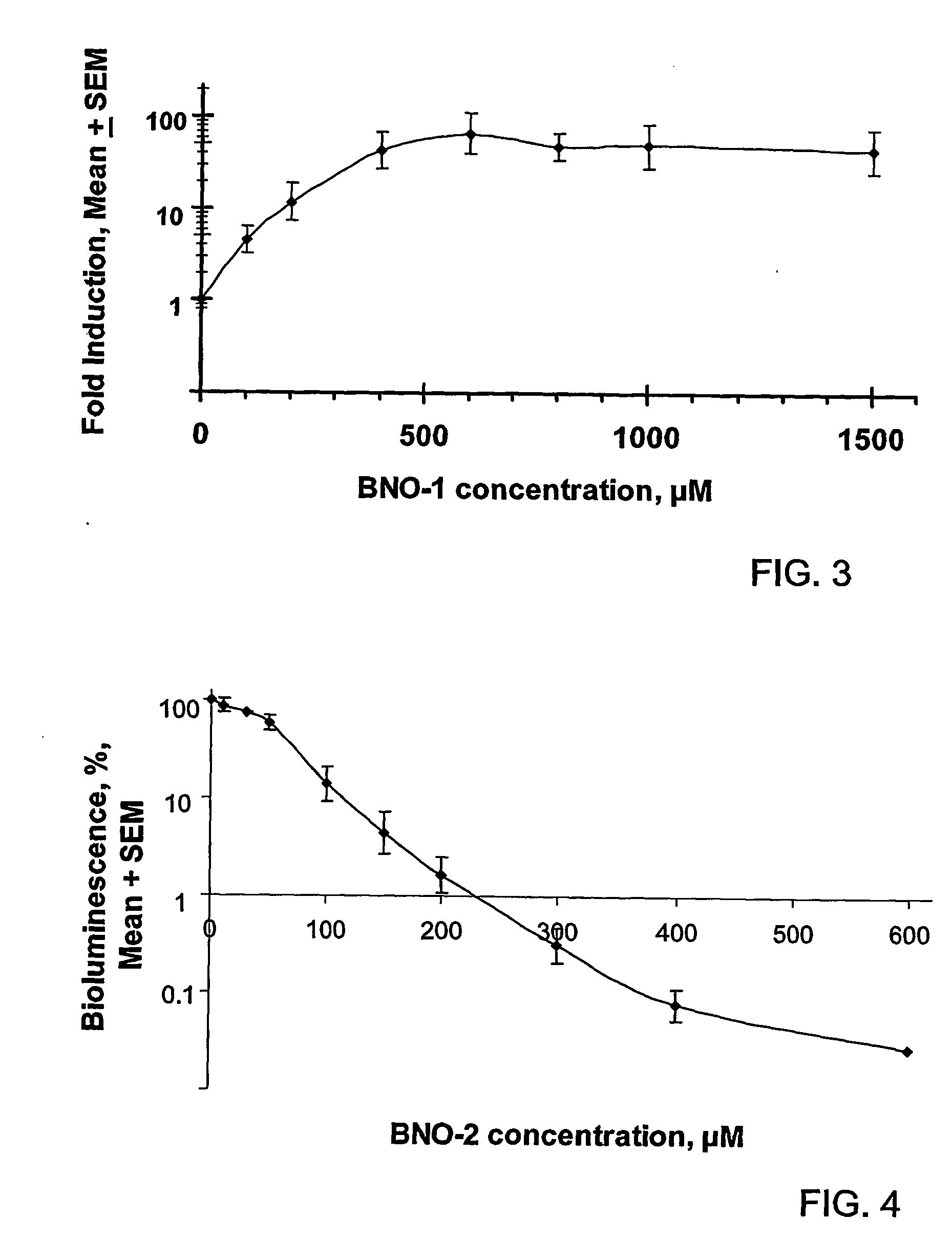Oxazaborolidines as bacteria effectors
a technology of oxazaborolidines and effectors, which is applied in the field of oxazaborolidines having biological effects, can solve the problems of affecting the survival rate of bacteria, and refractory treatment of persistent and chronic infections, so as to reduce the number of viable bacteria
- Summary
- Abstract
- Description
- Claims
- Application Information
AI Technical Summary
Benefits of technology
Problems solved by technology
Method used
Image
Examples
example 1
Effect of the Compounds of the Invention on Bacterial Viability
[0229] 1.1 Experimental
[0230] Sterile microculture dishes containing multiple wells were used to determine the minimal inhibitory concentration MIC) of eight derivatives of oxazborolidines. Each well contained 120 μl of brain heart infusion medium, 15 μl of an overnight suspension of S. mutans ATCC 27351 adjusted to 1 OD540 nm and 15 μl of the tested compound. Each compound was tested at five different concentrations between 0-50 mM. Each experiment was repeated twice. These cultures were incubated at 37° C. in atmosphere enriched in 5% CO2 for 24 hours. Bacteria growth was determined as turbidity of the over night growth and was determined by computerized ELISA reader (Thermomax microplate reader, Molecular Devices, USA) at 650 nm. Control cultures of bacteria with no oxazaborolidines added and media broth with the oxzaborilidines added but with no bacteria were conducted. MIC was determined as the lowest concentratio...
example 2
Effect of the Compounds of the Invention on Bacterial FTF Enzymatic Activity
[0233] 2.1 Experimental
[0234] Fructosyltransferase was purified as described by Rozen et al. (Rozen et al. FEMS Microbiol Lett., 2001, 195, 205-210; Rozen et al. APMIS, 2001, 109, 155-160). Briefly; a mixture of 200 ul purified FTF, 100 ul 1200 mM sucrose supplemented with 0.3 uCi ml-1 [3H]-fructose labelled sucrose and 100 ul of the tested compound at different concentrations was incubated at 37° C. for 3 h. the enzymatic reaction was terminated by the addition of ice-cold ethanol to a final concentration of 70%. Ethanol-insoluble fructans were isolated by overnight precipitation at 4° C. The precipitated fructans were washed three times with ethanol and placed over 25 mm glass fiber filters in multisample vacuum manifold. The filters containing the ethanol-insoluble fructans were dried by suction and placed in scintillation vials. The amount of radioactive-labeled fructans was measured in a scintillation...
example 3
Effect of the Compounds of the Invention on Bacterial Adhesion to a Substrate
[0237] 3.1 Experimental
[0238] 40 mg samples of hydroxyapatite (HA) beads (Ceramic hydroxyapatite type I, 80 um, Bio-Rad Laboratories, Hercules, Calif., USA)) (surface area, 0.63 cm2 / mg) were equilibrated with 3 washes of buffered KCl to which 250 μl of labeled radioactive bacteria (prepared as described above), 400 μl of the tested boronic compound and 50 μl of 700 mM sucrose (in KCl buffer solution) were added. The mixture was incubated for 60 min at 37 C with gentle rotation. At the end of the incubation period, the beads were washed 3 times with buffered KCl for removal of unbound components, especially the non-adsorbed labeled bacteria, and then rinsed with 2 ml ethanol into vials containing 10 ml scintillation fluid (Ecoscint A, National Diagnostics, Manville, N.J.). The amount of radioactively labeled bacteria adsorbed onto the HA beads was measured by scintillation counting (BETAmatic scintillation...
PUM
 Login to View More
Login to View More Abstract
Description
Claims
Application Information
 Login to View More
Login to View More - R&D
- Intellectual Property
- Life Sciences
- Materials
- Tech Scout
- Unparalleled Data Quality
- Higher Quality Content
- 60% Fewer Hallucinations
Browse by: Latest US Patents, China's latest patents, Technical Efficacy Thesaurus, Application Domain, Technology Topic, Popular Technical Reports.
© 2025 PatSnap. All rights reserved.Legal|Privacy policy|Modern Slavery Act Transparency Statement|Sitemap|About US| Contact US: help@patsnap.com



